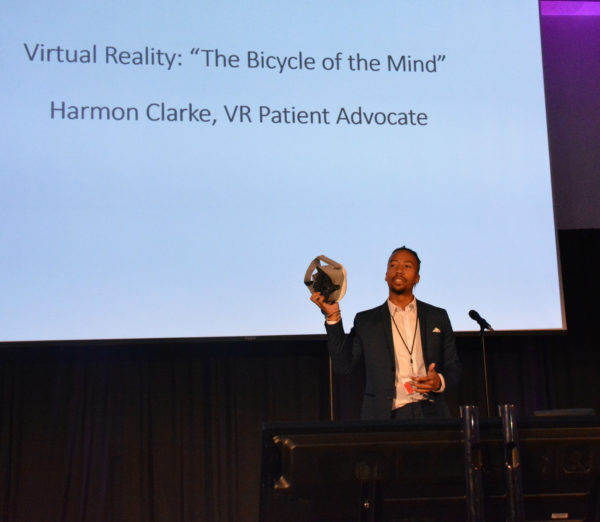by Dot Cannon
Cedars-Sinai has now announced dates for their third “Virtual Medicine” conference, March 25-26, 2020.
Harmon Clarke was sitting in a high school class when his heart began to pound.
At first, Harmon told the gathered audience during Day Two of Cedars-Sinai’s second Virtual Medicine conference in Los Angeles in March, he didn’t think anything of it.
After all, he was sitting behind a “cute girl”.
But then, he passed out…and woke up in the hospital.
Harmon had Crohn’s disease. As side effects, he had osteomyelitis and nodules on his lungs.
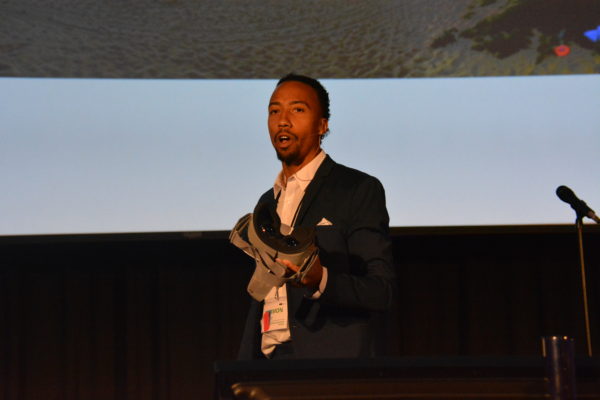
“I’m here today because this device saved my life,” said Harmon, who is now a VR patient advocate.
And throughout his presentation, entitled “VR: The Bicycle of the Mind”, he would illustrate the ways in which medical virtual reality had given him his life back.
Harmon said he began using VR, in place of opioids, during his second bout with the disease. Doctors had performed emergency surgery during his first hospitalization, removing his large intestine and giving him an osteomyelitis bag. They gave him morphine to combat the pain.
“I was 16,” he said.
The morphine, he said, gave him “mental fog”. When his friends came to visit, the normally-sharp young man found that he couldn’t think of his next chess move. As an escape from the pain and stress, he and his friends planned a “bucket list” of things he wanted to do in the future.
Gradually, Harmon recovered.
“Over the next ten years, all the things on that bucket list came true,” he said. He went to business school in Hawaii. He was studying Mandarin and headed for China on a scholarship.
But then, his Crohn’s flared up again.
Enter medical VR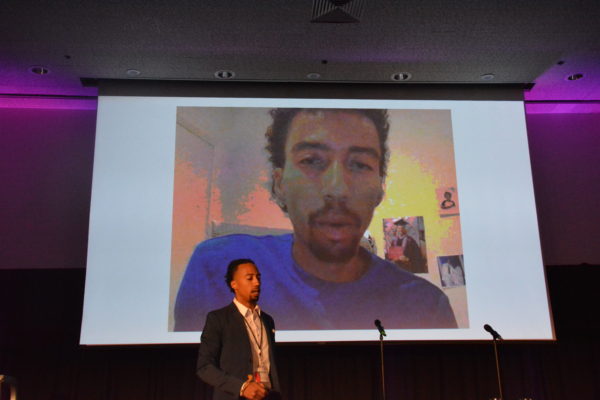
“Over the next three years my pain just got worse and worse,” Harmon continued. “I ended up back in Cedars (weighing) 108 pounds.”
The doctors, he said, prescribed the narcotic oxycodone to help manage the pain. “I literally thought I was dying.”
Three days before Christmas, Harmon’s doctors told him he would need another emergency operation. The fear, Harmon said, was “overwhelming”–and pain medications were his only way to deal with it.
Then, Dr. Brennan Spiegel came into his room with a “big, clunky headset”. Harmon said he was less than enthusiastic.
“I’m just like, really, VR? Give me my pain meds. Get out of here,” he said.
But Dr. Spiegel, who is Cedars-Sinai’s Director of Health Services Research, had Harmon don the headset–and so began the experience which the young man dubbed “the bicycle of the mind”.
“I was transported to Iceland. I was in a helicopter…and for those few moments, I wasn’t in the hospital,” he said.
The medical VR experiences, Harmon said, showed him how to manage his pain without opiates. Every time, thereafter, that he needed to escape from the hospital, or manage his pain, he’d reach for the headset.
And after his return home from the hospital, he was able to get professional help to wean him off the pain medication he’d been taking for three years. In its place, he used meditation–and VR.
“I take my goggles with me everywhere,” he said.
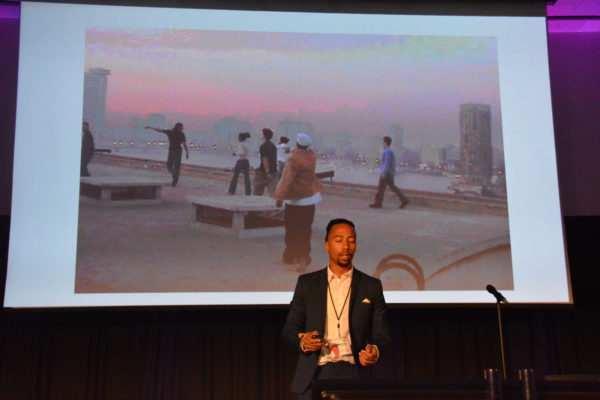
Today, Harmon teaches yoga, skydives and performs his music. He’s flown a plane over Los Angeles, snowboarded in Park City and traveled all over the world. He’s gone on safari. He has gained 45 pounds since his hospitalization. And at the time of his presentation, he was planning to go on tour, to Florida, as a cast member in a musical.
His musical and performance gifts also take him to a pain-free place, as his VR meditation does. “(When I was in the hospital), every day, after I’d do my VR meditation, I’d go to the piano (on the seventh floor),” he said.
Harmon showed the audience a very short video, of himself at the hospital playing a the opening bars of a song he’d written at Cedars…
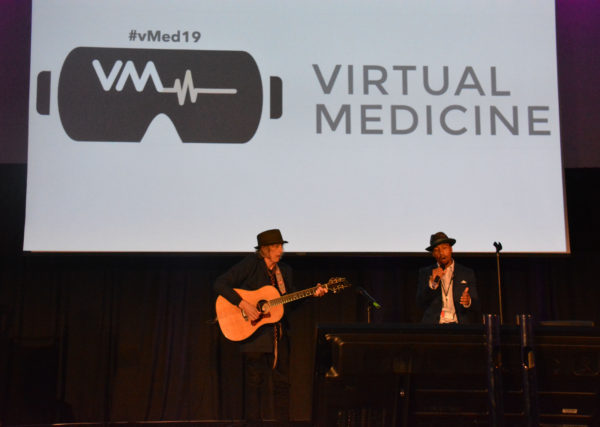
…which he then performed live: his original ballad ,”Let Me Fly”.
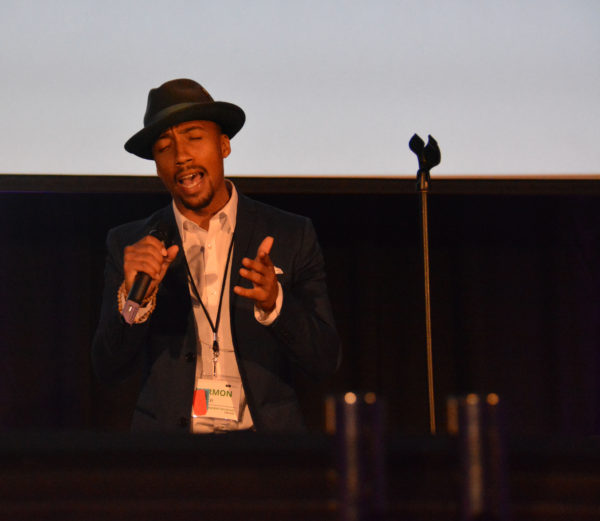
Then, he got playful with a rap about his VR experience–with help from his physician!
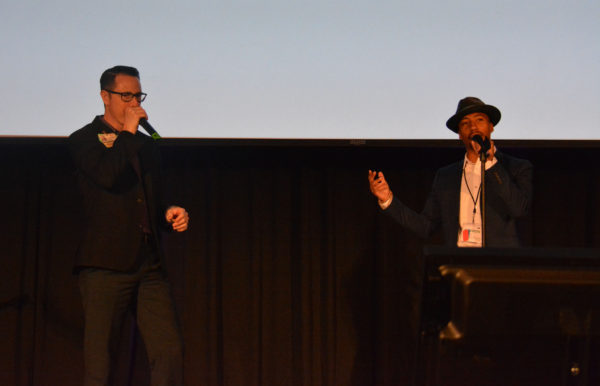
“Here we go. Give it up for Dr. Spiegel!” he called, before launching into a fast-paced rap that included the phrase, “discovering my purpose and living my passion”.
The audience applauded and whistled for both Harmon’s talent–and his journey.
“I’m performing and my dreams are coming true,” he had told them. “…And I’m telling you right now, this tool right here saved my life.
“…I was in a deep, dark place… Death was on its way. And I had no option other than the pain medicine, that was all I knew.
(With VR), I found that I could take my mind and body to a place without pain, and without pain medicine.”

